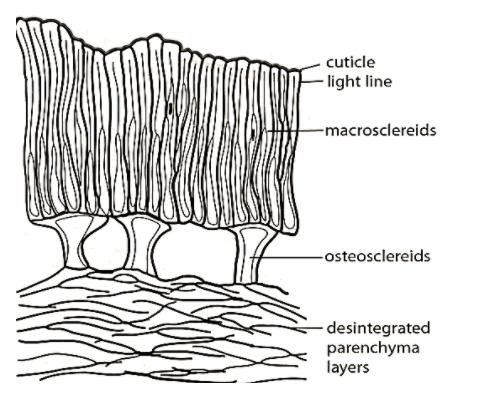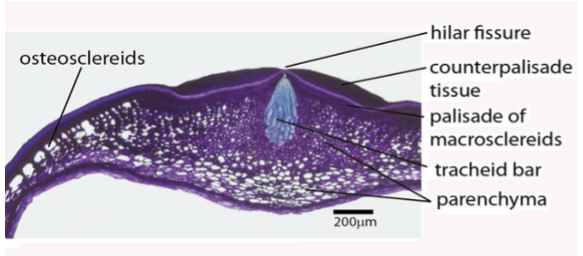
The types of sclereids present in the seed coat of the pulses, known as
A. Macrosclereids.
B. Astrosclereids.
C. Both of the above.
D. None of the above.
Answer
508.5k+ views
Hint: Seed coat of pulses (legumes) contain slightly elongated and columnar or rod-shaped cells that as whole form a palisade like outer layer.
Complete answer: Sclereids are part of the sclerenchyma tissue (reduced form of sclerenchyma) and exhibit a wide range of shapes and sizes.
They are present in several tissues of the plant, namely, the periderm, the cortex, the pith, the xylem, and also in the phloem.
Along with these structures they form a major part of fruits giving them the unique texture, and also constitute the hard shell of nuts and the outer coating in many seeds.
Testas i.e. seed coats of many plants, especially leguminous plants, are made up of two layers of macrosclereids.
Macrosclereids are elongated in shape. These cells are basically responsible for restricting the water uptake by hard seeded legumes. There is a visible light line present in a continuous line just beneath the outer surface of the macrosclereids in some legume seed coats. It is essentially due to the optical refraction properties possessed by these macro sclereid cells. Astrosclereids are another type of sclereids and have been found in the floating leaves of water lily. They are branched, pointed, and often star-shaped (hence the name astrosclereid). Given below is a clear diagram showing the arrangement of the macrosclereids in the seed coat of a legume.


So, the correct answer is A. Macrosclereids.
Note: These elongated sclereids are also referred to as ‘Malpighian cells’ after the pioneering Italian 17th century plant anatomist, Marcello Malpighi.
Complete answer: Sclereids are part of the sclerenchyma tissue (reduced form of sclerenchyma) and exhibit a wide range of shapes and sizes.
They are present in several tissues of the plant, namely, the periderm, the cortex, the pith, the xylem, and also in the phloem.
Along with these structures they form a major part of fruits giving them the unique texture, and also constitute the hard shell of nuts and the outer coating in many seeds.
Testas i.e. seed coats of many plants, especially leguminous plants, are made up of two layers of macrosclereids.
Macrosclereids are elongated in shape. These cells are basically responsible for restricting the water uptake by hard seeded legumes. There is a visible light line present in a continuous line just beneath the outer surface of the macrosclereids in some legume seed coats. It is essentially due to the optical refraction properties possessed by these macro sclereid cells. Astrosclereids are another type of sclereids and have been found in the floating leaves of water lily. They are branched, pointed, and often star-shaped (hence the name astrosclereid). Given below is a clear diagram showing the arrangement of the macrosclereids in the seed coat of a legume.


So, the correct answer is A. Macrosclereids.
Note: These elongated sclereids are also referred to as ‘Malpighian cells’ after the pioneering Italian 17th century plant anatomist, Marcello Malpighi.
Latest Vedantu courses for you
Grade 11 Science PCM | CBSE | SCHOOL | English
CBSE (2025-26)
School Full course for CBSE students
₹41,848 per year
Recently Updated Pages
Master Class 11 Business Studies: Engaging Questions & Answers for Success

Master Class 11 Accountancy: Engaging Questions & Answers for Success

Master Class 11 Computer Science: Engaging Questions & Answers for Success

Master Class 11 English: Engaging Questions & Answers for Success

Master Class 11 Social Science: Engaging Questions & Answers for Success

Master Class 11 Economics: Engaging Questions & Answers for Success

Trending doubts
Which one is a true fish A Jellyfish B Starfish C Dogfish class 11 biology CBSE

State and prove Bernoullis theorem class 11 physics CBSE

1 ton equals to A 100 kg B 1000 kg C 10 kg D 10000 class 11 physics CBSE

In which part of the body the blood is purified oxygenation class 11 biology CBSE

One Metric ton is equal to kg A 10000 B 1000 C 100 class 11 physics CBSE

Difference Between Prokaryotic Cells and Eukaryotic Cells




